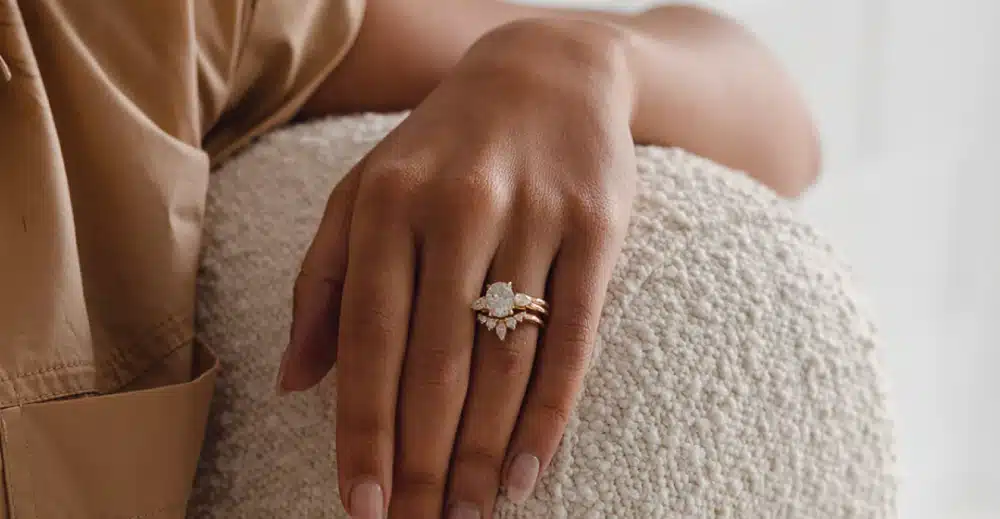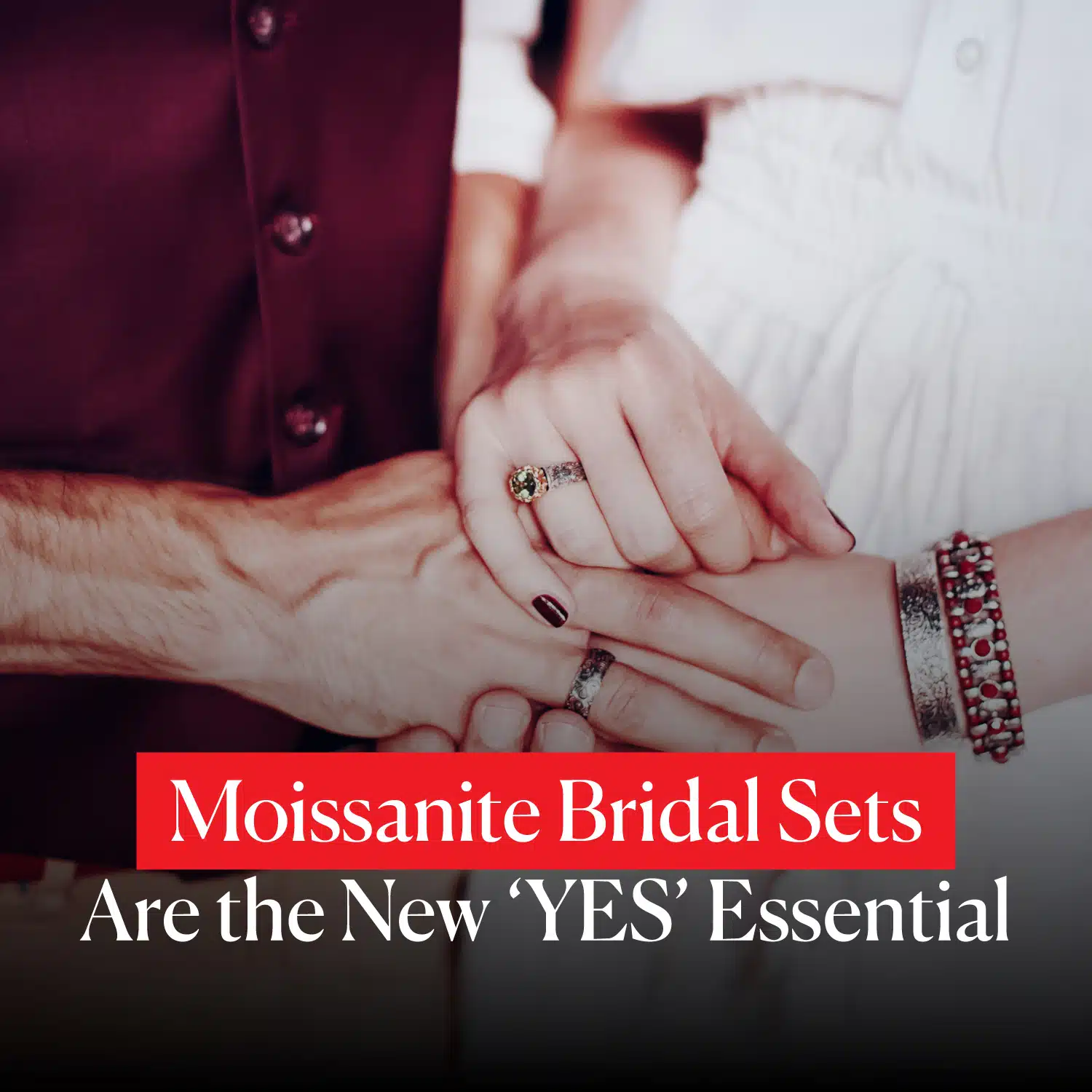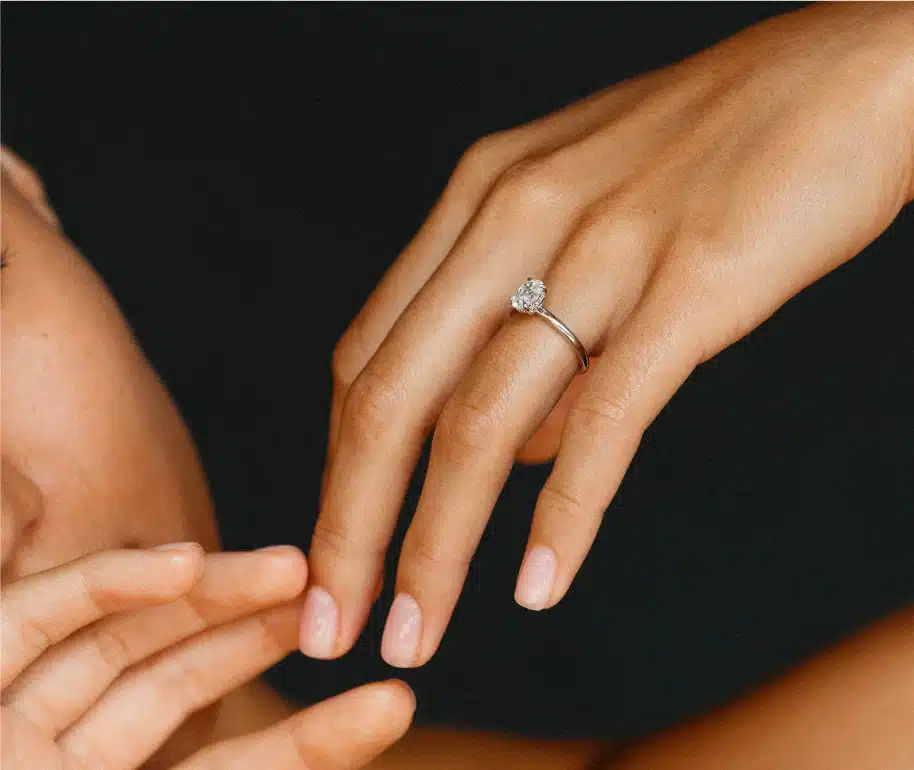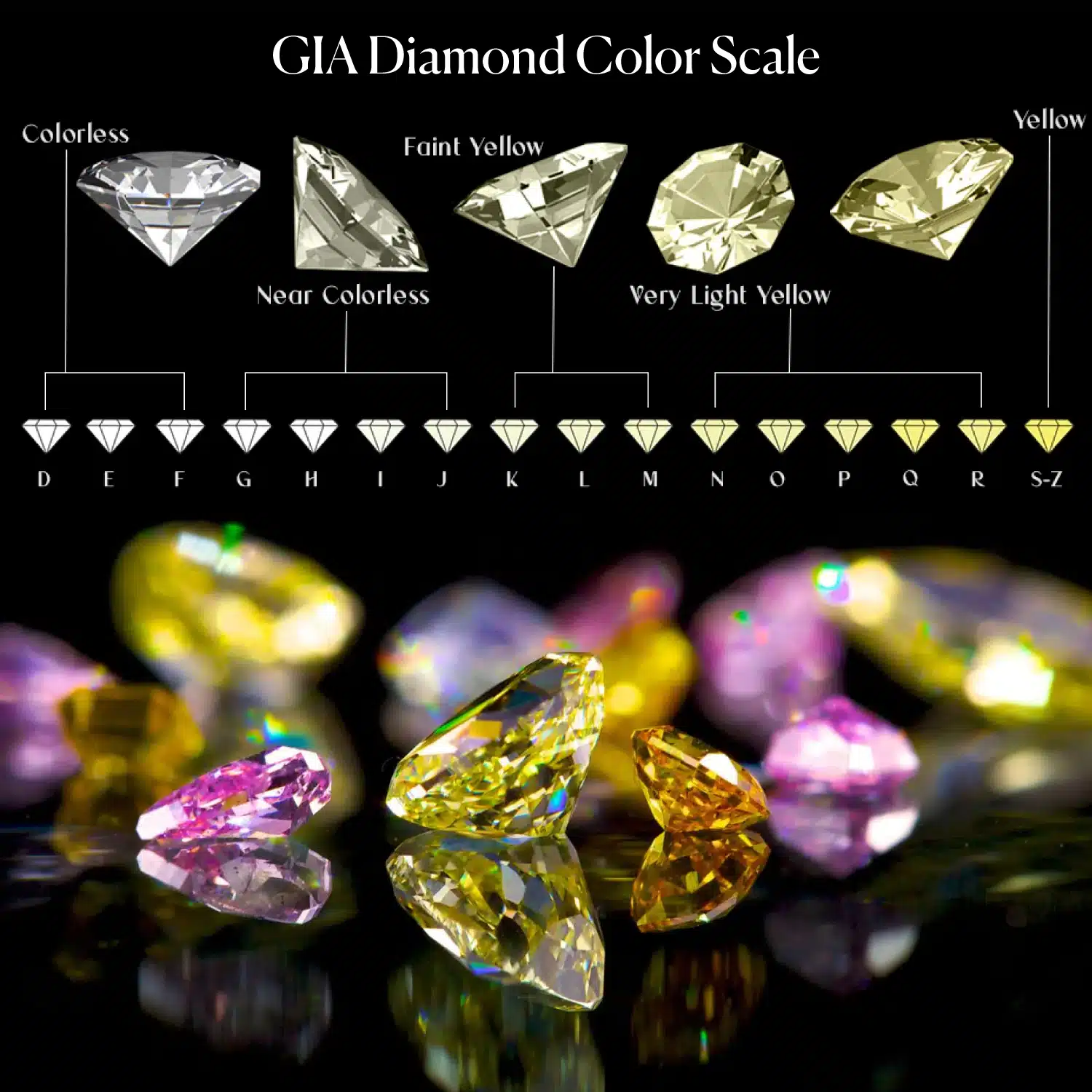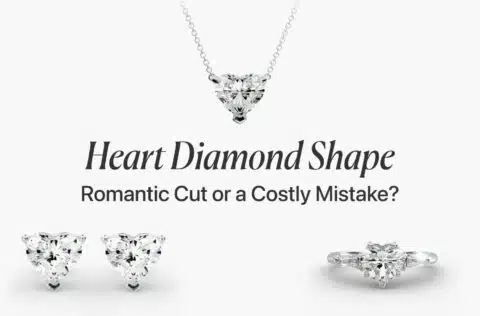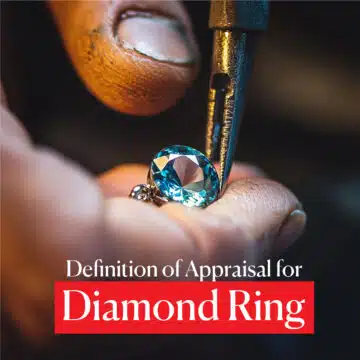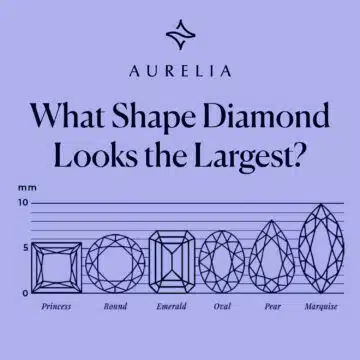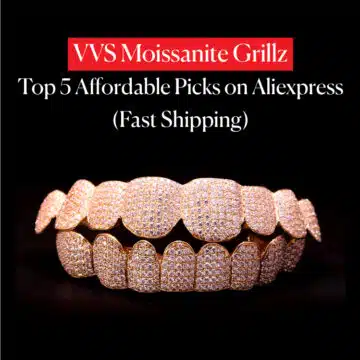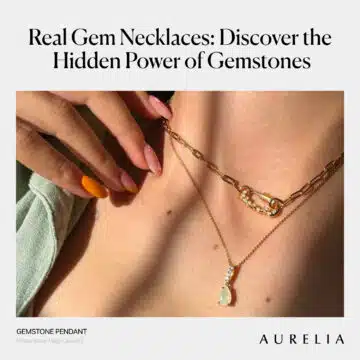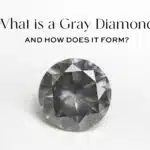Confused about diamond colors? Let’s break down the diamond color chart for you! I’m here to guide you through this sparkling journey with ease.
The diamond color chart is a key part of the GIA’s grading system, falling under the 4Cs in diamonds—cut, clarity, color, and carat—that determine a diamond’s quality. You can dive deeper into these in my diamond grading chart for the 4 Cs. It’s a simple way to understand what is the color of the diamond you’re eyeing.
Why does this matter? The diamond color scale affects how your diamond looks, its price, and even how it fits in engagement rings or jewelry. A diamond’s color can make it shine bright or add a warm glow, depending on the grade.
Here’s what we’ll explore together: an overview of the GIA scale, detailed looks at each color grade from D to Z, their pros and cons, pricing, best settings, clarity pairings, fancy colored diamonds, and answers to your FAQs. By the end, you’ll know exactly which of the diamond colors suits your style and budget. Let’s get started on this dazzling adventure!
- Understanding the Diamond Color Chart and GIA Scale
- D Color Diamonds: The Ultimate in Colorless Perfection
- E Color Diamonds: Nearly Perfect Colorless Beauty
- F Color Diamonds: The Last of the Colorless Range
- G Color Diamonds: Top of the Near-Colorless Range
- H Color Diamonds: A Popular Near-Colorless Choice
- I Color Diamonds: Affordable Near-Colorless Option
- J Color Diamonds: The Edge of Near-Colorless
- K Color Diamonds: Entering the Faint Yellow Range
- L Color Diamonds: Warmth with a Noticeable Tint
- N-Z Color Diamonds: Exploring the Light Yellow Range
- Fancy Colored Diamonds: Beyond the D-Z Scale
- How Diamond Color Affects Price and Resale Value
- Best Settings and Shapes for Different Diamond Colors
- Clarity Pairings Across the Diamond Color Scale
- Lighting Effects on Diamond Color
- Tips for Evaluating Diamond Color in Lighting
- Lab-Grown vs. Natural Diamonds: Color Considerations
- Pricing and Value Considerations
- FAQs on Diamond Color
- Conclusion
Understanding the Diamond Color Chart and GIA Scale
Let’s start with the basics of the diamond color chart—it’s the foundation for understanding diamond colors! The diamond color chart is the GIA’s standardized system for grading a diamond’s color, ranging from D (completely colorless) to Z (light yellow or brown). It’s a simple way to measure how diamonds are graded for their hue.
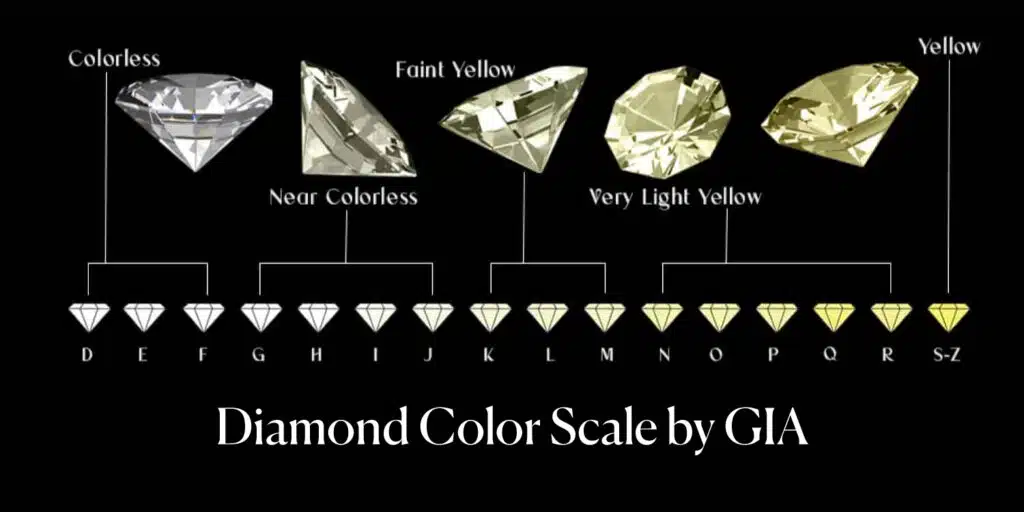
The GIA diamond chart plays a big role in the 4Cs—cut, clarity, color, and carat—which are the key factors in a diamond’s quality. The GIA, or Gemological Institute of America, is the gold standard in diamond grading, and as they say, “GIA puts the G in gorgeous” with its consistent process. This ensures every diamond’s color is judged fairly, no matter where you are.
So, how does the GIA color scale work in practice? Experts evaluate diamonds under controlled lighting, comparing them to a set of master stones to determine their color grade. This precise method guarantees accuracy in the diamond grading scale.
Now, let’s break down the diamond color scale from D to Z, so you can see what each grade means. Each grade has distinct characteristics that affect a diamond’s look and price. Here’s a quick overview:
- D: Completely colorless, the rarest and most valuable.
- E-F: Also colorless, with tiny traces of color only experts can spot.
- G-J: Near-colorless, with a slight tint that’s hard to notice unless you’re comparing side by side.
- K-M: Faint yellow tint, more noticeable but still beautiful, especially in warm settings.
- N-R: Light yellow, where the tint becomes more visible to the naked eye.
- S-Z: Light yellow to brown, the most tinted on the scale, offering a bold, unique look.
Here’s a fun fact to impress your friends: the GIA introduced the D-Z scale in 1953, setting the global standard for diamond grading scale practices. This system has been the benchmark for over 70 years! You can learn more about the process on GIA’s official color grading guide.
The GIA scale ensures consistency in diamond grading worldwide, whether you’re buying a natural or lab-grown stone. Curious about lab-grown diamonds? Check out my guide on GIA certified synthetic diamonds to see how they’re graded too.
Understanding the diamond color chart is your first step to picking the perfect diamond. It’s all about finding the balance between color, budget, and style that works for you. We’ll dive deeper into each grade next, so you’ll know exactly what to look for!
D Color Diamonds: The Ultimate in Colorless Perfection

Let’s kick things off with D color diamonds—the cream of the crop in the diamond world! A D color diamond is the highest grade on the GIA scale, meaning it’s completely colorless and the rarest of all diamond color grades. If you’re looking for the best color diamond, this is where you start.
What makes D color so special? It’s the ultimate in colorless diamond perfection, with no trace of yellow or brown tint, even under magnification. This makes it a top choice for luxury buyers who want a diamond that sparkles with pure, icy brilliance.
Pros: Why You’ll Love D Color Diamonds
Here’s what makes D color diamonds a top pick for perfection seekers.
- Pure Whiteness: D color offers unmatched brightness, making it a true colorless diamond that shines in any light.
- Ideal for Any Setting: Whether it’s white gold, platinum, or yellow gold, a D color diamond looks stunning in every metal.
- Highest Resale Value: These diamonds hold their value best, often reselling for 60-70% of their original price.
Cons: What to Consider Before Choosing D Color
Even the best has a few drawbacks—here’s what to keep in mind.
- Most Expensive: D color is often the most expensive diamond color on the D-Z scale, so it’s a big investment—check out my guide on what color diamond is the most expensive for more details.
- May Feel Too “Icy”: Some people find D color’s stark whiteness a bit too cold, preferring a warmer tone for their jewelry.
Pricing and Availability: What to Expect with D Color
Let’s look at some real-world examples to see what you’re paying for. A 1-carat D color, VS2 clarity, excellent cut diamond at James Allen costs $6,800. The same specs at Blue Nile will run you $6,900.
What about the numbers behind D color’s popularity? StoneAlgo (2024) reports that D color diamonds make up just 5% of sales but command 60% higher prices than E color diamonds. That rarity comes with a premium, but it’s worth it for many buyers.
When it comes to wearability, D color diamonds are timeless. They show no wear in terms of color degradation, meaning their brilliance lasts forever. StoneAlgo (2024) also notes their popularity has grown 12% since 2020, as more people seek the ultimate luxury.
How does D compare to the next grade? A D color diamond offers unmatched whiteness for luxury buyers, making it whiter than E color—check out my D Color Diamond guide for a deeper dive. This makes D the go-to choice if you’re after the ultimate colorless look, especially in white gold settings where the contrast really pops.
So, is a D color diamond right for you? If you want the best of the best and don’t mind the price, it’s a stunning option. We’ll explore E color next to see how it stacks up!
E Color Diamonds: Nearly Perfect Colorless Beauty
Next up on our journey through the diamond color grades is the stunning E color diamond! An E color diamond is virtually colorless, making it very rare and just a step below the top-tier D color. It’s a fantastic choice if you’re after a colorless diamond that’s still a luxury pick.
What sets E color apart? It has the tiniest trace of color, but you’d need a magnifying glass and a trained eye to spot it. This near-perfect whiteness makes E color a favorite for those who want brilliance without the top-tier price.
Pros: Why E Color Diamonds Shine Bright
Here’s what makes E color diamonds a dazzling choice for your jewelry.
- Near-Perfect Whiteness: E color offers a colorless diamond look that’s almost as white as D, giving you stunning sparkle.
- Excellent for All Settings: From white gold to yellow gold, an E color diamond looks amazing in any metal.
- High Resale Value: These diamonds hold their value well, often reselling for 55-65% of their original price.
Cons: What to Think About with E Color
Even near-perfection has a few trade-offs—here’s what to consider.
- High Cost: E color diamonds are still pricey, though they’re slightly more affordable than D color.
- Minimal Difference from D: To the naked eye, the difference between E and D is so small that some feel the price gap isn’t worth it.
How E Color Compares: D vs. E vs. F

Let’s see how E color stacks up against its closest neighbors. E is slightly less white than D but whiter than F, making it a great choice for those wanting a colorless diamond look at a slightly lower price.
If you’re set on the ultimate whiteness, D might be your pick, but E offers nearly the same brilliance for less. For budget-conscious buyers, F color (which we’ll cover next) might be tempting, though it’s a touch less white than E.
Pricing and Availability: What to Expect with E Color
Let’s check out some real-world examples to see the cost. A 1-carat E color, VS2 clarity, excellent cut diamond at James Allen will set you back $6,500. The same specs at Blue Nile cost $6,600.
What do the numbers say about E color’s popularity? StoneAlgo (2024) shows E color diamonds make up 8% of sales, with prices 5% lower than D but 50% higher than F color. That makes E a sweet spot for many buyers seeking luxury without the top-tier price.
When it comes to wearability, E color diamonds are a dream. They’re durable, with no color wear over time, so their brilliance lasts forever. StoneAlgo (2024) also notes their popularity has increased 10% since 2020, as more people discover their value.
An E color diamond offers a near-perfect colorless appearance, and you can learn more in my E Color Diamond guide. It’s a fantastic option if you want a diamond that looks colorless but saves you a bit compared to D. We’ll explore F color next to see how it compares!
F Color Diamonds: The Last of the Colorless Range
Let’s wrap up the colorless range with the fabulous F color diamonds! An F color diamond is the final grade in the colorless category (D-F) on the GIA scale, showing just a faint tint under magnification that’s invisible to most of us. Among the diamond color grades, F strikes a perfect balance, giving you a colorless diamond look without the higher price tag of D or E.
Why does F color stand out? It delivers that crisp, icy brilliance you’d expect from a top-tier diamond, making it a go-to for those who want luxury on a budget. In fact, 15% of diamond buyers choose F color, making it one of the most popular picks in the colorless range.
Pros: Why F Color Diamonds Are a Smart Pick
Here’s what makes F color diamonds a brilliant choice for your next piece.
- Still Colorless: F color falls in the colorless diamond range, offering a bright, white sparkle that’s hard to beat.
- More Affordable Than D-E: You’ll save compared to D or E grades while still getting that premium colorless look.
- Great for White Gold Settings: F color pops beautifully in white gold or platinum, highlighting its diamond F color brilliance.
Cons: What to Consider with F Color
F color diamonds are stunning, but let’s look at a couple of trade-offs.
- Slightly Less White Than D-E: F has a faint tint compared to D or E, though you’d need a magnifying glass to notice it.
- Pricier Than Near-Colorless Grades: F costs more than near-colorless grades like G or H, which might offer better value if you’re budget-focused.
Even with these considerations, F color diamonds are a fantastic choice for most buyers. Let’s explore how they compare to other grades to see if F is your perfect match.
How F Color Compares: E vs. F vs. G
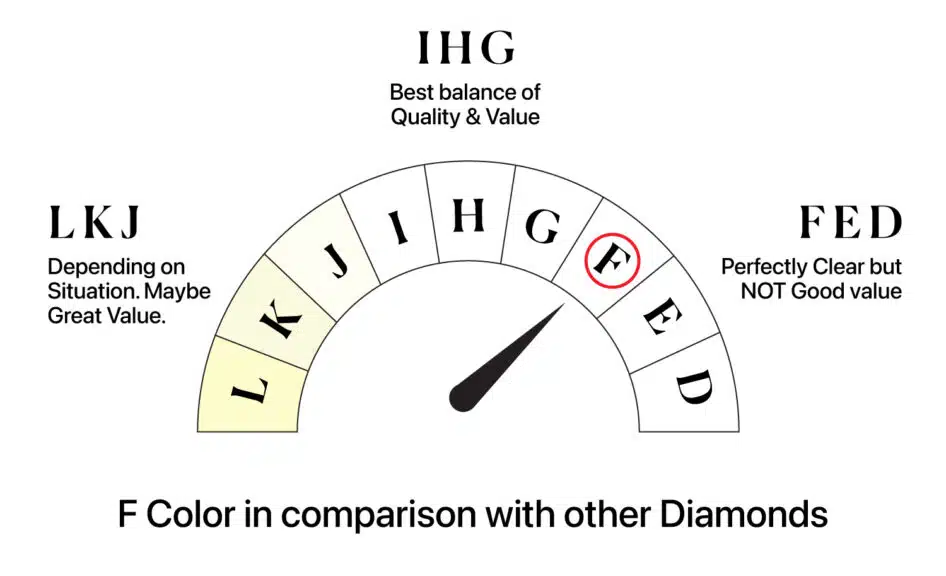
Let’s see where F color stands next to E and G on the scale. F is just a touch less white than E (chosen by 10% of buyers) but whiter than G (picked by 13%), making it ideal for those seeking a colorless diamond on a budget.
If you’re after the whitest possible diamond, E might be worth the splurge, but F still delivers that colorless sparkle at a better price. Meanwhile, G color, which we’ll cover next, enters the near-colorless range and may show a slight tint in larger stones.
Pricing and Availability: What to Expect with F Color
Let’s break down the cost with some examples. A 1-carat F color, VS2 clarity, excellent cut diamond at James Allen is priced at $6,200. The same specs at Blue Nile will cost you $6,300.
What do the stats say about F color’s place in the market? A 2024 report from the International Gem Society notes that F color diamonds account for about 12% of sales in the colorless range, with prices typically 8-10% lower than E but 35-40% higher than G.
Meanwhile, Statista (2024) highlights that the average price per carat for diamonds in this range has seen a slight dip, making F color an even better value this year.
When it comes to wearability, F color diamonds are a lasting choice. They show no color wear over time, so their sparkle stays as stunning as the day you bought them. Their popularity has held steady since 2018, reflecting their consistent appeal among buyers.
An F color diamond provides a colorless look at a more accessible price, and you can learn more in my F Color Diamond guide. It’s a great option if you want that white, brilliant look without the premium cost of D or E. Next, we’ll step into the near-colorless range with G color diamonds!
G Color Diamonds: Top of the Near-Colorless Range
We’re stepping into the near-colorless range with G color diamonds, and I’m excited to show you why they’re such a popular pick! A G color diamond is the top grade in the near-colorless category (G-J) on the GIA scale, with a slight tint that’s only visible under magnification by a trained eye. For anyone asking, “Is G color diamond good?”—it’s a fantastic choice, offering excellent value and a white appearance that rivals higher grades.
What makes G color so appealing? To the naked eye, this near colorless diamond looks bright and white, with no noticeable yellow tint in most settings. It’s a smart pick if you want a high-quality diamond without the premium price of the colorless range (D-F).
Pros: Why G Color Diamonds Are a Winner
Here’s what makes G color diamonds a top choice for value and beauty.
- Looks White to the Naked Eye: G color offers a near colorless diamond appearance that shines bright in everyday lighting.
- Versatile for All Settings: Whether you choose white gold, yellow gold, or platinum, a G color diamond looks stunning in any metal.
- More Affordable Than F: You’ll save significantly compared to F color, making G a budget-friendly yet premium option.
Cons: What to Watch Out for with G Color
G color diamonds are amazing, but there are a couple of things to keep in mind.
- Slight Tint in Larger Stones: In diamonds over 2 carats, the faint tint might be more noticeable, especially in certain lighting.
- Not as White as Colorless Grades: G is whiter than H but doesn’t quite match the icy perfection of D-F grades.
These drawbacks are minor for most buyers, especially since the tint is so subtle. Let’s see how G color compares to its neighbors to help you decide if it’s the right fit for you.
How G Color Compares: F vs. G vs. H

Let’s break down how G color stacks up against F and H on the scale. G is whiter than H (chosen by 14% of buyers) but slightly less white than F (picked by 15%), making it a top choice for value-driven buyers who still want a near colorless diamond.
If you’re after the whitest look possible, F might be worth the extra cost, but G offers nearly the same brilliance for less. On the other hand, H color, which we’ll explore next, has a bit more warmth that might show in larger stones or white gold settings.
Pricing and Availability: What to Expect with G Color
Let’s look at some pricing examples to see what you’d pay for a G color diamond. A 1-carat G color, VS2 clarity, excellent cut diamond at James Allen costs $4,800. The same specs at Blue Nile are $4,900, while at Ritani you’d pay around $4,850.
What do the stats say about G color’s popularity? According to recent data, G color diamonds make up 13% of diamond purchases, reflecting their strong appeal among buyers. The International Gem Society (2024) also notes that G color diamonds are typically 15-20% less expensive than F but 25-30% more than H, making them a sweet spot for value.
When it comes to wearability, G color diamonds are a durable choice. They show no color wear over time, so their brilliance lasts a lifetime. Their popularity has grown steadily, with a 5% increase in demand since 2020, as more buyers recognize their balance of quality and affordability.
A G color diamond offers a near-colorless look at a great price, and you can learn more in my G Color Diamond guide. It’s perfect for anyone who wants a white, sparkling diamond without stretching their budget too far. Next, we’ll dive into H color diamonds to see how they compare!
H Color Diamonds: A Popular Near-Colorless Choice
Let’s dive deeper into the near-colorless range with H color diamonds, a favorite for many jewelry lovers! An H color diamond falls in the near-colorless category (G-J) on the GIA scale, with a slight tint that might be visible in larger stones but still offers a great balance of whiteness and price.
If you’re looking for a near colorless diamond that won’t break the bank, color H is a fantastic option to consider.
Why are H color diamonds so loved? They look white in most settings, especially in smaller sizes, and their affordability makes them a go-to for budget-conscious buyers. This diamond color H I range is perfect for those who want a white diamond without the premium cost of colorless grades.
Pros: Why H Color Diamonds Are a Hit
Here’s what makes H color diamonds a popular pick for stunning jewelry.
- Affordable: H color is more budget-friendly than G, making it easier to get a larger or higher-quality diamond.
- Looks White in Most Settings: In most lighting and metals, an H color diamond appears bright and white to the naked eye.
- Popular for Engagement Rings: Many couples choose H color for its balance of beauty and value, especially for engagement rings.
Cons: What to Know About H Color
H color diamonds are great, but there are a couple of things to keep in mind.
- Tint More Noticeable Than G: The slight yellow tint in H color can be more visible than in G, especially in larger stones over 2 carats.
- Not Colorless: H doesn’t match the icy whiteness of D-F grades, so it’s not technically a colorless diamond.
Don’t let these minor drawbacks deter you—H color diamonds still offer a beautiful white look for most purposes. Let’s see how H compares to its neighbors to help you decide if it’s the right choice for your jewelry.
How H Color Compares: G vs. H vs. I

Let’s see how H color measures up to G and I on the scale. H is less white than G (picked by 13% of buyers) but whiter than I (chosen by 14%), making it a great option for those wanting a near colorless diamond on a budget.
If you prefer a whiter look, G might be worth the extra cost, but H still delivers a bright appearance for less. Meanwhile, I color, which we’ll cover next, has a more noticeable tint that might show in white gold settings or larger stones.
Pricing and Availability: What to Expect with H Color
Here’s a look at what you’ll pay and where to find H color diamonds. A 1-carat H color, VS2 clarity, excellent cut diamond at James Allen costs $4,200. The same specs at Blue Nile will run you $4,300. For more on saving with this grade, check out my H Color Diamond pricing tips to make the most of color H’s affordability.
What do the stats say about H color’s popularity? Recent data shows H color diamonds make up 14% of diamond purchases, reflecting their widespread appeal. RapNet (2024) also reports that H color diamonds are typically 10-15% less expensive than G but 20-25% more than I, positioning them as a value-driven choice.
When it comes to wearability, H color diamonds are a reliable pick. They show no color wear over time, meaning their sparkle stays intact for years. Their popularity has remained steady since 2015, as more buyers appreciate their balance of quality and cost.
An H color diamond is a popular choice for engagement rings, and you can learn more in my H Color Diamond guide. It’s a great option if you want a white-looking diamond that fits your budget. Next, we’ll explore I color diamonds to see how they compare!
I Color Diamonds: Affordable Near-Colorless Option
We’re continuing our journey through the near-colorless range with I color diamonds, a fantastic choice for budget-savvy shoppers! An I color diamond falls in the near-colorless category (G-J) on the GIA scale, with a slight yellow tint that can be visible in larger stones but still offers a budget-friendly option.
If you’re exploring the diamond color H I range, I color is a great pick for a near colorless diamond that keeps costs down.
What sets I color apart? It looks nearly white in smaller sizes or certain settings, but the faint yellow tint might show in larger stones, especially under close inspection. This makes I color a practical choice for those who want a white-looking diamond without the higher price of G or H.
Pros: Why I Color Diamonds Are a Great Deal
Here’s what makes I color diamonds a smart choice for your jewelry.
- More Affordable Than H: I color is significantly less expensive than H, letting you save or splurge on other diamond qualities.
- Looks White in Yellow Gold: The slight tint of an I diamond colour blends beautifully with yellow gold, masking any warmth.
- Good Value: You get a near colorless diamond look at a fraction of the cost of higher grades, making I a budget winner.
Cons: What to Consider with I Color
I color diamonds offer great value, but there are a few things to keep in mind.
- Tint More Noticeable Than H: The yellow tint in I color is more visible than in H, especially in stones over 1.5 carats.
- Not Ideal for White Gold in Larger Sizes: In white gold or platinum, the tint might stand out more, particularly in larger diamonds.
These factors are worth considering, but I color diamonds can still look stunning with the right setting and size. Let’s see how I compares to its neighbors to help you decide if it’s the perfect fit for your needs.
How I Color Compares: H vs. I vs. J

Let’s break down how I color stacks up against H and J on the scale. I is less white than H (chosen by 14% of buyers) but whiter than J (picked by 10%), making it a good choice for budget buyers who prefer yellow gold over white gold for their near colorless diamond.
If you want a whiter appearance, H might be worth the extra cost, but I offers a similar look for less. On the other hand, J color, which we’ll explore next, has a more noticeable tint that might be too warm for some settings.
Pricing and Availability: What to Expect with I Color
Here’s a look at what you’ll pay and where to find I color diamonds. A 1-carat I color, VS2 clarity, excellent cut diamond at James Allen costs $3,500. The same specs at Blue Nile will run you $3,600.
What do the stats say about I color’s place in the market? Recent data shows I color diamonds make up 14% of diamond purchases, reflecting their popularity among budget-conscious buyers. RapNet (2024) also reports that I color diamonds are typically 15-20% less expensive than H but 10-15% more than J, making them a solid value option.
When it comes to wearability, I color diamonds are a dependable choice. They show no color wear over time, so their sparkle remains intact for years. Their popularity has remained steady since 2018, as more buyers appreciate their affordability and versatility.
An I diamond colour offers a near-colorless look at a lower price, and you can learn more in my I Color Diamond guide. It’s a great pick if you’re looking for a white-looking diamond on a budget, especially in yellow gold settings. Next, we’ll explore J color diamonds to see how they compare!
J Color Diamonds: The Edge of Near-Colorless
We’ve reached the final grade in the near-colorless range with J color diamonds, and I’m excited to share why they’re a hidden gem for budget shoppers! A J color diamond marks the edge of the near-colorless category (G-J) on the GIA scale, with a noticeable yellow tint in larger stones but still a great option for those prioritizing affordability.
Among the diamond color grades, J color offers a budget-friendly way to get a white-looking diamond with the right setting.
What makes J color unique? It’s the most affordable grade in the near-colorless range, but the slight yellow tint can be more visible, especially in larger stones or certain settings. This makes J color a practical choice for those who want a diamond that looks white without the higher cost of G, H, or I.
Pros: Why J Color Diamonds Are a Budget Win
Here’s what makes J color diamonds a fantastic choice for savvy buyers.
- Budget-Friendly: J color is the most affordable in the near-colorless range, letting you save big or invest in a larger stone.
- Looks White in Yellow Gold: The faint tint of a J color diamond blends beautifully with yellow gold, hiding any warmth.
- Good for Smaller Stones: In diamonds under 1 carat, the tint is often hard to notice, making J a great value pick.
Cons: What to Keep in Mind with J Color
J color diamonds are a steal, but there are a few things to consider.
- Tint Visible in White Gold: The yellow tint in J color can be more noticeable in white gold or platinum, especially in larger stones.
- Lower Resale Value: Compared to higher grades, J color diamonds don’t hold their value as well over time.
These factors might influence your choice, but J color diamonds can still look amazing with the right approach. Let’s see how J compares to its neighbors to help you decide if it’s the perfect diamond for you.
How J Color Compares: I vs. J vs. K
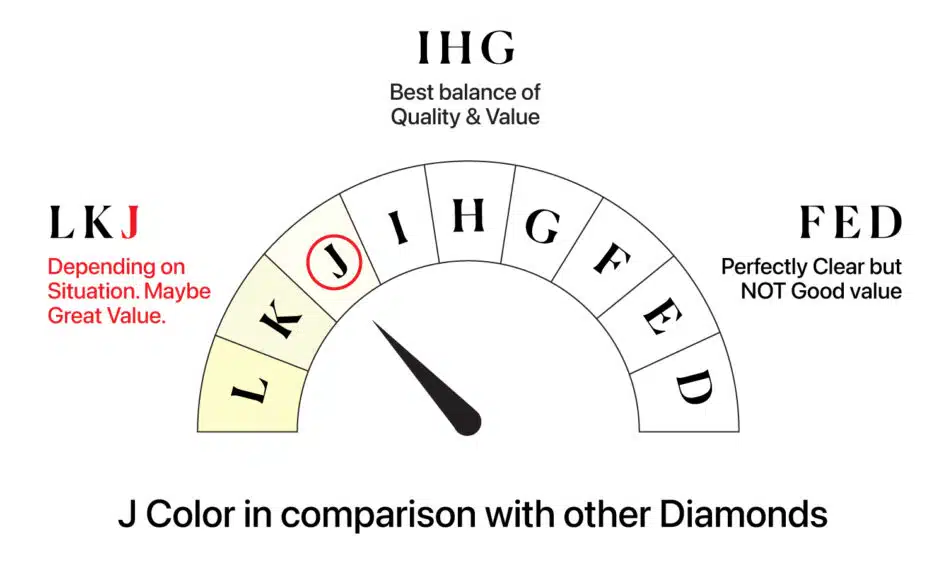
Let’s break down how J color stacks up against I and K on the scale. J is less white than I (chosen by 14% of buyers) but whiter than K (picked by 8%), making it a solid choice for budget buyers who want a near colorless diamond in the right setting. If you prefer a whiter look, I might be worth the extra cost, but J still offers a near-colorless appearance for less.
On the other hand, K color, which we’ll explore next, moves into the faint yellow range with a more noticeable tint.
Pricing and Availability: What to Expect with J Color
Here’s a look at what you’ll pay and where to find J color diamonds.
A 1-carat J color, VS2 clarity, excellent cut diamond at James Allen costs $2,900. The same specs at Blue Nile will run you $3,000.
What do the stats say about J color’s popularity? Recent data shows J color diamonds make up 10% of diamond purchases, reflecting their appeal among budget-conscious buyers. RapNet (2024) also reports that J color diamonds are typically 10-15% less expensive than I but 10-15% more than K, positioning them as a great value option in the near-colorless range.
When it comes to wearability, J color diamonds are a dependable choice. They show no color wear over time, so their sparkle remains intact for years. Their popularity has remained steady since 2015, as more buyers discover their affordability and versatility.
A J color diamond offers a near-colorless look at a budget-friendly price, and you can learn more in my J Color Diamond guide. It’s a great pick if you’re looking for a white-looking diamond in yellow gold settings without spending too much.
K Color Diamonds: Entering the Faint Yellow Range
We’re now stepping into the faint yellow range with K color diamonds, and I’m excited to show you how they can add a unique charm to your jewelry! A K color diamond marks the start of the faint yellow category (K-M) on the GIA scale, with a subtle yellow tint that’s noticeable but still offers a warm, vintage appeal.
Among the diamond color grades, K color is a budget-friendly option for those who love a bit of warmth in their diamonds.
What makes K color special? The faint yellow tint gives K color diamonds a cozy, vintage vibe, making them a great choice for unique, non-traditional pieces. It’s perfect if you’re looking for a diamond that stands out without the higher cost of near-colorless grades.
Pros: Why K Color Diamonds Are a Unique Choice
Here’s what makes K color diamonds a great pick for vintage lovers.
- Affordable: K color is much less expensive than near-colorless grades, letting you save or invest in a larger stone.
- Warm Vintage Appeal: The subtle yellow tint of a K color diamond adds a classic, timeless charm to your jewelry.
- Ideal for Yellow Gold: K color shines beautifully in yellow gold settings, where the tint blends seamlessly with the metal.
Cons: What to Consider with K Color
K color diamonds have a unique charm, but there are a few things to keep in mind.
- Tint Visible in White Gold: The yellow tint in K color can be more noticeable in white gold or platinum settings, especially in larger stones.
- Lower Resale Value: Compared to higher grades, K color diamonds don’t hold their value as well over time.
These aspects might influence your decision, but K color diamonds can still look stunning with the right setting and style. Let’s see how K compares to its neighbors to help you decide if it’s the right diamond for you.
How K Color Compares: J vs. K vs. L
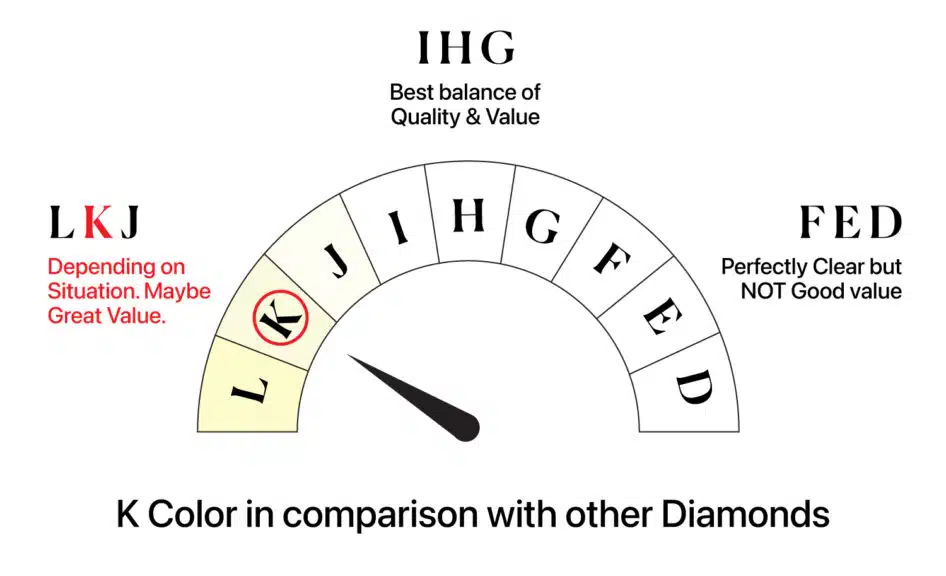
Let’s break down how K color stacks up against J and L on the scale. K is less white than J (chosen by 10% of buyers) but whiter than L (picked by 4%), making it a good choice for those who love the warm tone of a faint yellow diamond in vintage settings.
If you prefer a whiter look, J might be a better fit, but K offers a more pronounced warmth for less. On the other hand, L color, which we’ll explore next, has a deeper yellow tint that might be too noticeable for some preferences.
Pricing and Availability: What to Expect with K Color
Here’s a look at what you’ll pay and where to find K color diamonds. A 1-carat K color, VS2 clarity, excellent cut diamond at James Allen costs $2,500. The same specs at Blue Nile will run you $2,600.
What do the stats say about K color’s popularity? Recent data shows K color diamonds make up 8% of diamond purchases, reflecting their niche appeal among buyers who love a warm hue. RapNet (2024) also reports that K color diamonds are typically 15-20% less expensive than J but 10-15% more than L, positioning them as a budget-friendly option in the faint yellow range.
When it comes to wearability, K color diamonds are a solid choice. They show no color wear over time, so their warm sparkle remains intact for years. Their popularity has seen a slight decline of 3% since 2020, as more buyers opt for whiter grades, but they remain a favorite for vintage-inspired jewelry.
A K color diamond offers a warm, faint yellow tint for budget buyers, and you can learn more in my K Color Diamond guide. It’s a great pick if you’re looking for a unique, vintage-style diamond in yellow gold settings.
L Color Diamonds: Warmth with a Noticeable Tint
We’re diving deeper into the faint yellow range with L color diamonds, and I’m thrilled to show you their unique charm! An L color diamond falls in the faint yellow category (K-M) on the GIA scale, with a noticeable yellow tint that adds warmth but is more pronounced than K color. Among the diamond color grades, L color is a budget-friendly choice for those who love a vintage, warm-toned diamond.
What sets L color apart? The yellow tint is more visible to the naked eye, especially in larger stones, giving L color diamonds a cozy, golden glow. This makes them a great pick if you’re after a diamond with character and a lower price tag.
Pros: Why L Color Diamonds Are a Vintage Gem
Here’s what makes L color diamonds a special choice for unique jewelry.
- Affordable: L color is much cheaper than higher grades, letting you save or splurge on a larger stone or unique design.
- Vintage Charm: The warm yellow tint of an L color diamond adds a classic, nostalgic vibe to your jewelry.
- Perfect for Yellow Gold: L color looks stunning in yellow or rose gold settings, where the tint complements the metal beautifully.
Cons: What to Think About with L Color
L color diamonds have a distinct warmth, but there are a few things to consider.
- Yellow Tint More Visible: The tint in L color is more noticeable than in K, especially in larger stones or under certain lighting.
- Not Ideal for White Gold: In white gold or platinum, the yellow hue can stand out, making L less suitable for those settings.
These considerations might guide your choice, but L color diamonds can still be breathtaking with the right approach. Let’s see how L compares to its neighbors to help you decide if it’s the perfect diamond for your style.
How L Color Compares: K vs. L vs. M
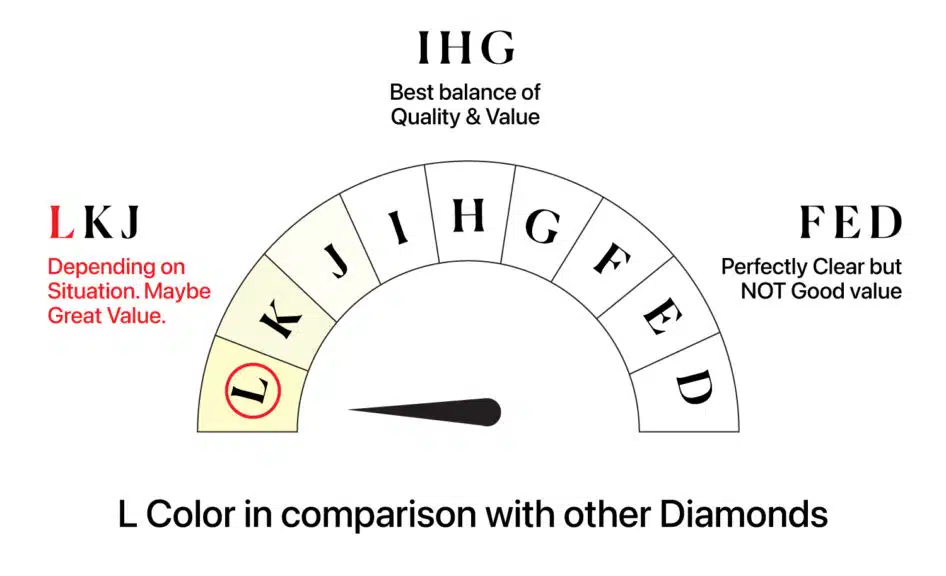
Let’s break down how L color stacks up against K and M on the scale. L is less white than K (chosen by 8% of buyers) but whiter than M (not in the provided stats), making it a good pick for those who enjoy the warmth of a faint yellow diamond in vintage designs.
If you prefer a subtler tint, K might be a better fit, but L offers a deeper golden hue for less. On the other hand, M color, which we’ll explore next, has an even more pronounced yellow tint that might be too bold for some preferences.
Pricing and Availability: What to Expect with L Color
Here’s a look at what you’ll pay and where to find L color diamonds. A 1-carat L color, VS2 clarity, excellent cut diamond at James Allen costs $2,200. The same specs at Ritani will run you $2,100.
What do the stats say about L color’s popularity? Recent data shows L color diamonds make up 4% of diamond purchases, reflecting their niche appeal among buyers who love a warm hue. The International Gem Society (2024) also notes that L color diamonds are typically 10-15% less expensive than K but 5-10% more than M, positioning them as a budget-friendly option in the faint yellow range.
When it comes to wearability, L color diamonds are a reliable choice. They show no color wear over time, so their warm glow remains intact for years. Statista (2024) highlights that their demand has remained steady since 2018, as buyers continue to appreciate their unique vintage appeal.
An L color diamond brings a warm, vintage glow to jewelry, and you can learn more in my L Color Diamond guide. It’s a great pick if you’re looking for a budget-friendly diamond with a golden hue, especially in yellow gold settings.
N-Z Color Diamonds: Exploring the Light Yellow Range
We’re now venturing into the warm, golden hues of N-Z color diamonds, where the light yellow diamonds on the color of diamonds scale offer a unique charm for budget-conscious buyers! These diamonds, ranging from N to Z on the GIA scale, fall within the faint yellow to light yellow category, with a noticeable yellow tint that becomes more pronounced as you move down the scale.
If you’re looking for affordable diamond colors that add a bold, vintage flair to your jewelry, this range is a treasure trove of possibilities.
What makes the N-Z range so intriguing? These diamond color grades are known for their warm, light yellow tint, which can be a stunning feature in the right setting, especially for those who love a pop of color in their yellow diamond jewelry.
Let’s break down what these grades offer, their pros and cons, how they compare, and what the market says about their value.
Overview of N-Z Color Diamonds
Here’s a quick look at what defines N-Z color diamonds and their place on the color scale.
N-Z color diamonds span the light yellow range, starting with N, where the yellow tint is noticeable to the naked eye, and ending with Z, the deepest yellow on the D-Z color of diamonds scale.
As you move from N to Z, the yellow hue intensifies, making these diamonds more affordable but also more distinct in their warmth. They’re perfect for those who embrace the unique glow of light yellow diamonds and want a budget-friendly option for bold jewelry pieces.
Why choose an N-Z color diamond? The noticeable yellow tint gives these diamonds a vintage, golden charm that’s ideal for statement pieces, especially in yellow gold settings. However, the tint can be a drawback if you prefer the icy whiteness of higher grades like D-F.
Pros and Cons of N-Z Color Diamonds
Let’s weigh the benefits and drawbacks of choosing a diamond in the N-Z range.
Pros:
- Low Cost: N-Z color diamonds are among the most affordable diamond colors, making them a great choice for budget buyers.
- Bold Warmth: The light yellow diamonds in this range offer a unique, warm hue that adds character to yellow diamond jewelry.
- Ideal for Yellow Gold: These diamonds shine in yellow or rose gold settings, where the tint blends beautifully with the metal.
Cons:
- Pronounced Yellow Tint: The yellow hue becomes more noticeable as you move from N to Z, which might not suit everyone’s taste.
- Not Suitable for White Gold: In white gold or platinum, the tint of N-Z diamonds can stand out, making them less ideal for those settings.
- Low Resale Value: These grades have lower resale value compared to higher color grades due to their noticeable color.
These pros and cons make N-Z color diamonds a niche choice, perfect for those who love their warm glow but less ideal if you’re after a colorless look. Let’s see how each grade in this range compares to its neighbors.
How N-Z Colors Compare
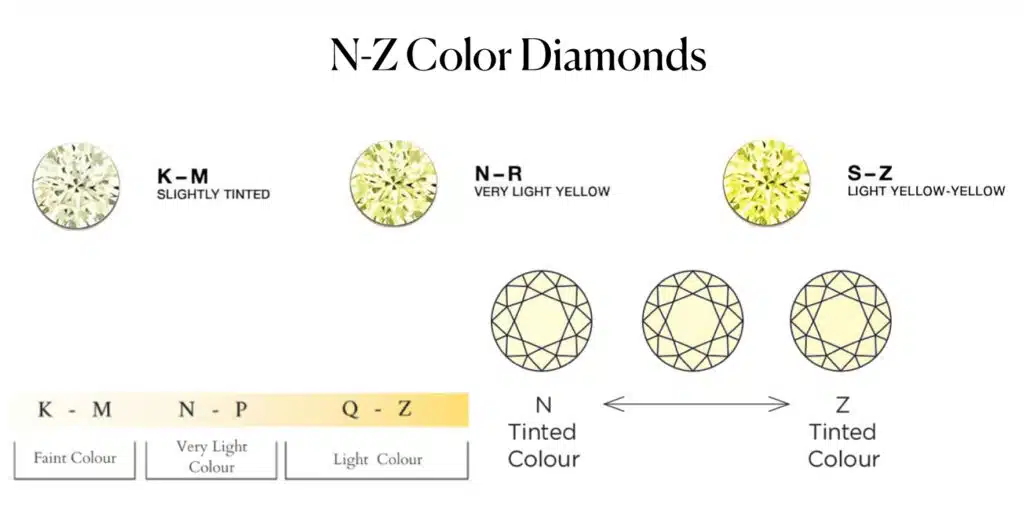
Let’s compare N through Z color diamonds to see how their yellow intensity and appeal differ.
The N-Z range progresses from a light yellow tint at N to a very deep yellow at Z, with each grade offering a slightly more intense hue than the one before.
To help you visualize the differences, I’ve put together a comparison table that breaks down the yellow intensity, suitability for settings, and overall vibe of each grade. This will help you decide which diamond color grades best suit your style and budget.
| Color Grade | Yellow Intensity | Best Setting | Vibe |
|---|---|---|---|
| N Color | Light yellow, noticeable | Yellow gold | Subtle warmth, vintage charm |
| O Color | Light yellow, more intense | Yellow gold | Warm and bold |
| P Color | Deeper light yellow | Yellow gold | Striking warmth |
| Q Color | More intense yellow | Yellow gold | Bold and unique |
| R Color | Deep light yellow | Yellow gold | Striking and bold |
| S Color | More pronounced yellow | Yellow gold | Very bold, unique |
| T Color | Deepening yellow | Yellow gold | Deep, warm glow |
| U Color | Very deep yellow | Yellow gold | Very bold, statement-making |
| V Color | Deep yellow, bold | Yellow gold | Striking, golden hue |
| W Color | Very deep yellow | Yellow gold | Deep, vintage glow |
| X Color | Deep yellow, striking | Yellow gold | Bold, golden statement |
| Y Color | Very deep yellow | Yellow gold | Very deep, warm hue |
| Z Color | Deepest yellow on D-Z | Yellow gold | Boldest, most unique |
Each grade in the N-Z range offers a unique level of warmth, making them ideal for yellow diamond jewelry that stands out. If you prefer a subtler yellow, N or O might be your pick, while Z offers the boldest hue for a true statement piece. The colors of diamonds like U or Y provide a very deep yellow hue, perfect for vintage-inspired designs.
Pricing and Market Trends for N-Z Color Diamonds
Let’s dive into the market stats and pricing trends for N-Z color diamonds. N-Z color diamonds are some of the most affordable diamond colors on the market, with prices decreasing as the yellow tint becomes more pronounced.
According to recent data, N color diamonds make up 4% of sales, while O and P are at 3% and 2%, respectively, and Q through Z each account for 1% of sales. The International Gem Society (2024) notes that prices for N color diamonds are typically 25% lower than M but 10% higher than O, with this trend continuing down the scale—Z color diamonds are 15% cheaper than Y, making them the most budget-friendly on the D-Z scale.
What does this mean for you? If you’re looking for a bold piece of yellow diamond jewelry, you can get a larger stone in the N-Z range without stretching your budget. Statista (2024) highlights that demand for these grades has remained steady since 2018, as buyers increasingly appreciate their unique warmth for fashion pieces.
When it comes to wearability, N-Z color diamonds are a durable choice. They show no color wear over time, meaning their golden hue stays vibrant for years. This makes them a reliable option for everyday light yellow diamonds jewelry, especially in yellow gold settings where their tint can truly shine.
Fancy Colored Diamonds: Beyond the D-Z Scale

Let’s step into the dazzling world of fancy colored diamonds, where vibrant hues like yellow, pink, blue, and red take center stage beyond the D-Z scale! Unlike the colorless to light yellow diamonds we’ve covered, colored diamonds come in a stunning array of natural shades, making them a rare and exciting choice for unique jewelry.
If you’re curious about the most expensive diamond color or just want a pop of color in your collection, this section is for you.
What makes these diamonds so special? Rare colored diamonds get their hues from natural impurities or structural defects—nitrogen for yellow, boron for blue, or unique conditions for pink and red—making each one a natural masterpiece.
The GIA grades them based on hue, tone, and saturation, with terms like Fancy Light, Fancy Intense, and Fancy Vivid indicating the strength of their color.
Rarity and Value of Fancy Colored Diamonds
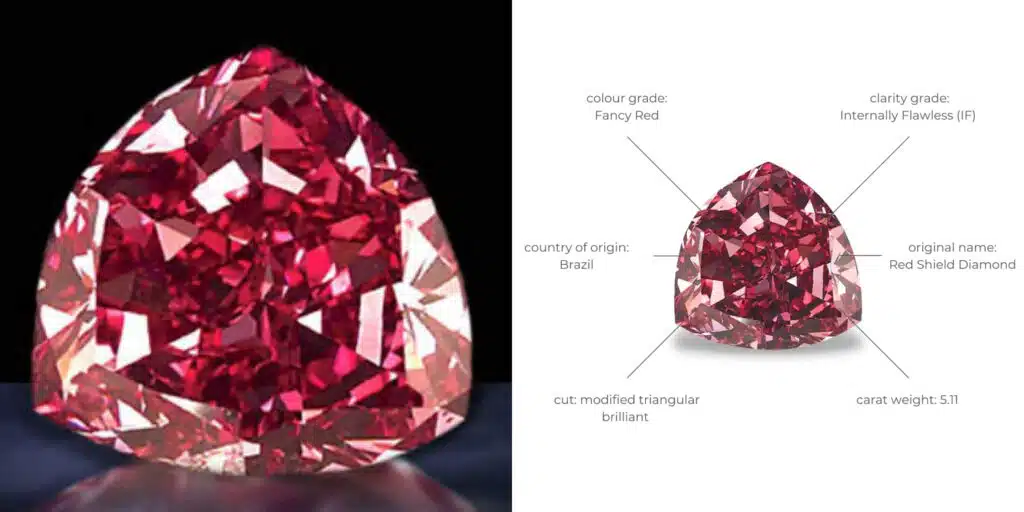
How rare are these colorful gems, and what do they cost? Among colored diamonds, pink and blue are the rarest, often commanding jaw-dropping prices due to their scarcity. For example, a 1-carat fancy vivid pink lab diamond at James Allen can cost $50,000+, while a natural one would be even pricier.
A 2023 Sotheby’s auction made headlines when a 10-carat fancy vivid blue diamond sold for $44 million, showcasing why blue is often the most expensive diamond color (source: Sotheby’s).
Why are they so valuable? The GIA (2024) notes that less than 0.1% of diamonds mined are fancy colored, with pinks and blues being the rarest due to their unique formation conditions. This rarity makes them a favorite for collectors and luxury buyers looking for something truly one-of-a-kind.
Spotlight on Yellow Diamonds: Are They More Expensive?
Let’s zoom in on yellow diamonds and their pricing. You might be wondering, “Are yellow diamonds more expensive?” The answer depends on their grade—fancy yellow diamonds graded as Fancy Vivid can indeed be pricey, with a 1-carat Fancy Vivid Yellow at Blue Nile costing around $10,000.
However, lighter yellows (like those in the D-Z scale) are far more affordable, so it’s the intensity of the color that drives the price.
What about ethical concerns? The origins of colored diamonds can raise ethical concerns, which you can explore in my guide on why do we refer to some diamonds as conflict materials. Opting for lab-grown options can help you avoid these issues while still enjoying a stunning hue.
Lab-Grown Options for Fancy Colored Diamonds
Can you get these vibrant hues without the high cost? If the price of natural rare colored diamonds feels out of reach, lab-grown options offer a fantastic alternative. A pink lab diamond offers a more affordable alternative to natural colored stones, and you can learn more about these in my guide on types of lab-grown diamonds.
These lab-grown gems provide the same vibrant colors at a fraction of the cost, making them a popular choice for budget-conscious buyers.
How do they compare in the market? Statista (2024) reports that lab-grown colored diamonds have seen a 15% increase in demand since 2021, as more buyers seek ethical and affordable options. This trend makes it easier than ever to add a splash of color to your jewelry collection.
Styling and Wearability of Fancy Colored Diamonds

How can you make these gems shine in your jewelry? Fancy colored diamonds are as durable as colorless ones, showing no color wear over time, so their vibrant hues will last a lifetime. They’re perfect for statement pieces—think a fancy yellow diamond in a pendant or a fancy blue diamond in earrings—where their color can truly pop.
Pair them with complementary metals, like yellow gold for yellow diamonds or white gold for blue diamonds, to enhance their natural beauty.
Fancy colored diamonds open up a world of creativity for your jewelry. Whether you’re drawn to the rarity of a fancy pink diamond or the bold warmth of a yellow one, these gems let you express your unique style. They’re a stunning way to go beyond the D-Z scale and make a bold, colorful statement!
How Diamond Color Affects Price and Resale Value
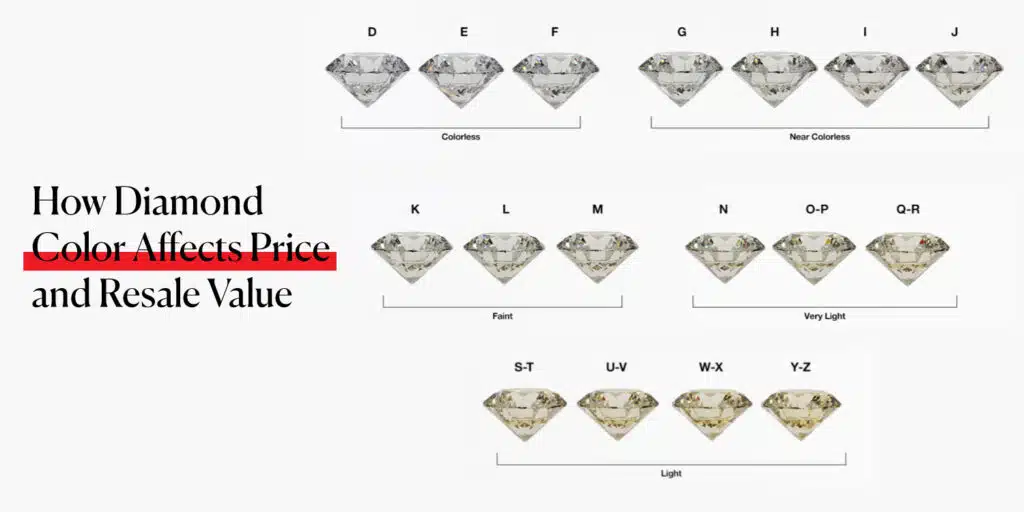
Let’s talk about how diamond color grade impacts both the price you pay and the diamond resale value you can expect down the line! The diamond color ratings on the GIA scale, from D to Z, play a huge role in determining a diamond’s cost, with colorless grades commanding the highest prices and yellow-tinted ones being more affordable. Understanding this can help you make a smart choice, whether you’re buying for love or investment.
Why does color matter so much? A diamond’s color affects its rarity and appearance—D color diamonds are the rarest and most colorless, making them the priciest, while Z color diamonds have a noticeable yellow tint, making them the least expensive.
This price difference can be significant, depending on where your diamond falls on the diamond rating scale.
Price Differences Across Color Grades
How much does color affect what you’ll pay? The higher the color grade, the more you’ll pay for a diamond, as colorless stones are rarer and more sought after.
For example, a 1-carat D color, VS2 clarity, excellent cut diamond at James Allen costs $6,800, while a 1-carat L color at Blue Nile is $2,200, and a 1-carat Z color at Ritani is just $600. Understanding diamond color ratings can help you find the best value, and you can dive deeper in my H Color Diamond pricing tips.
What does this mean for your budget? If you’re looking for a white-looking diamond without the high cost, near-colorless grades like G or H might be a sweet spot. However, if you love the warm hue of a Z color diamond, you’ll save significantly while still getting a beautiful stone.
Resale Value Across Color Grades
How much can you expect when reselling your diamond? The diamond resale value also varies widely based on color grade, with higher grades retaining more of their original value. A D color diamond typically resells for 60-70% of its original price.
For example, a $6,800 D color might fetch $4,500—while an L color resells for 40-50%, like $1,200 for a $2,200 L, and a Z color resells for just 30%, such as $200 for a $600 Z. StoneAlgo (2024) reports that D color diamonds retain 25% more resale value than L color, making them a better long-term investment.
What else affects resale? Diamond resale value also depends on the diamond cut clarity scale, which you can learn more about in my guide on what is a diamond’s culet also learn where to sell lab grown diamonds. Factors like clarity and cut quality can further influence how much you’ll get back when you sell.
Choosing the Right Color for Your Goals
If you’re buying a diamond as an investment, a higher diamond color grade like D or E might be worth the splurge due to its better resale potential. However, if you’re focused on affordability and don’t plan to sell, a lower grade like L or Z can still give you a beautiful stone at a fraction of the cost. It’s all about finding the right balance for your budget and style.
Understanding how color impacts price and resale value can help you make a confident decision. Whether you’re drawn to the icy brilliance of a D color or the warm glow of a Z color, knowing the financial implications ensures you get the most value. This knowledge lets you shop smarter, no matter your priorities!
Best Settings and Shapes for Different Diamond Colors

Let’s find the best color for diamond settings and shapes to make your diamond shine its brightest! The color of a diamond plays a big role in how it looks in a ring, and choosing the right metal and shape can either highlight its whiteness or complement its warmth.
I’ll guide you through the best settings and diamond shapes for different color grades, so you can make your diamond pop in the perfect way.
Why do settings and shapes matter? The metal you choose can either enhance or mask the diamond ring colors, while the shape of the diamond affects how its color appears to the eye. Let’s break it down by color range to help you find the best match for your stone.
Best Settings for Different Diamond Colors
Which metals make your diamond’s color stand out? For D-F color diamonds, which are colorless, white gold or platinum settings highlight their icy whiteness beautifully—for example, a 1-carat D color, VS2 clarity, excellent cut at James Allen looks stunning in a platinum setting.
If you’re working with K-M color diamonds, which have a faint yellow tint, yellow or rose gold complements their warmth, like a 1-carat L color, VS2 clarity, excellent cut at Blue Nile paired with a yellow gold band.
For N-Z color diamonds, which have a noticeable yellow hue, yellow gold creates a bold, cohesive look—think a 1-carat Z color, VS2 clarity, excellent cut at Ritani in a yellow gold setting for a striking effect.
What does this mean for you? Choosing the right setting for diamond ring colors can enhance their beauty, as I explore in my benefits of a low-set engagement ring. The right metal can make your diamond’s color pop or blend seamlessly, depending on the look you’re going for.
Best Shapes for Different Diamond Colors

How does the shape of your diamond affect its color? The shape of your diamond can either hide or highlight its color, depending on how it reflects light. A round brilliant cut is great for hiding tint, making it ideal for diamonds with a slight yellow hue—for example, a 1-carat K color, VS2 clarity, round brilliant at James Allen will look whiter than its grade suggests.
On the other hand, cushion or radiant cuts show more color due to their larger facets, like a 1-carat M color, VS2 clarity, cushion cut at Ritani, where the faint yellow tint is more noticeable.
Why does shape matter? Different diamond shapes can affect how color appears, which you can learn more about in my diamond cut chart. Choosing the right shape can help you balance the color of a diamond with its overall appearance.
Tips for Pairing Settings and Shapes
How can you combine settings and shapes for the best look? If you have a D-F color diamond, pair a round brilliant cut with a white gold setting to maximize its brilliance and whiteness. For K-M or N-Z color diamonds, opt for a cushion or radiant cut in yellow gold to embrace their warm tones and create a cohesive, vintage-inspired look.
This combination of setting and shape ensures your diamond’s color is showcased in the best possible way.
Finding the best color for diamond settings and shapes is all about enhancing your diamond’s natural beauty. Whether you’re highlighting the whiteness of a D color or embracing the warmth of a Z color, the right combination can make your ring truly shine. With these tips, you’ll be able to create a piece that’s as stunning as it is personal!
Clarity Pairings Across the Diamond Color Scale
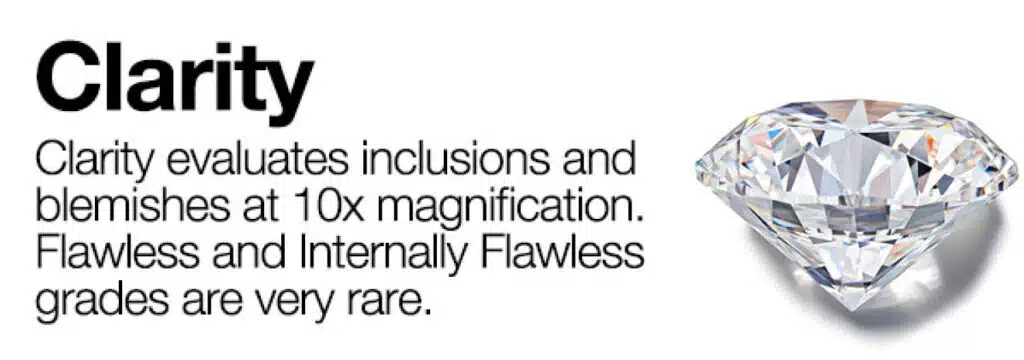
Let’s dive into how diamond color and clarity work together to create a stunning diamond that fits your style and budget! The diamond clarity and color combination is key to a diamond’s overall look, as clarity affects how clean it appears, while color determines its whiteness or warmth.
I’ll show you the best clarity pairings for each color range on the GIA scale, so you can find what is a good diamond clarity for your diamond.
Why does this pairing matter? Clarity grades, from Flawless to I3, measure a diamond’s inclusions, and pairing the right clarity with your diamond color grade ensures your stone looks its best. Let’s break it down by color range to help you make the perfect choice.
Clarity Pairings for D-F Color Diamonds
What clarity works best for colorless diamonds? For D-F color diamonds, which are colorless and prized for their brilliance, a clarity of VS2 or higher ensures their sparkle isn’t dulled by inclusions—for example, a 1-carat D color, VS2 clarity, excellent cut at James Allen will look flawless to the naked eye.
These high clarity grades complement the icy whiteness of D-F diamonds, letting their brilliance shine through. A clarity color diamond chart can help you find the right balance, as I explain in my diamond color and clarity chart.
Why aim for VS2+? In colorless diamonds, inclusions are more noticeable because there’s no tint to mask them, so a higher clarity grade ensures a clean, sparkling look. This pairing maximizes the premium look of D-F grades.
Clarity Pairings for K-M Color Diamonds
What clarity suits faint yellow diamonds? For K-M color diamonds, which have a faint yellow tint, a clarity of SI1 or higher offers an eye-clean look without breaking the bank—for instance, a 1-carat L color, SI1 clarity, excellent cut at Blue Nile will appear clean to the naked eye despite its lower color grade.
The slight tint in K-M diamonds can help mask minor inclusions, making SI1 a great choice for value. This balance ensures your diamond looks beautiful without overpaying for unnecessary clarity.
What does this mean for you? Since the faint yellow hue already adds warmth, you can save on clarity without sacrificing appearance, as long as the diamond is eye-clean. SI1+ strikes the perfect balance for K-M grades.
Clarity Pairings for N-Z Color Diamonds
What clarity works for light yellow diamonds? For N-Z color diamonds, which have a noticeable yellow tint, a clarity of SI1 or higher is ideal to avoid distractions from inclusions—for example, a 1-carat Z color, SI1 clarity, excellent cut at Ritani will look clean despite its bold hue.
The yellow tint can draw attention to inclusions, so sticking with SI1+ ensures the focus stays on the diamond’s warm color. This pairing keeps your diamond looking attractive without compromising on budget.
Why avoid lower clarity grades? You should steer clear of I3 clarity, as visible inclusions can detract from the diamond’s beauty—for instance, a 1-carat L color, I3 clarity at Ritani will have noticeable flaws that distract from its overall look. Lower clarity grades like I3 can make inclusions too obvious, especially in larger stones.
How Clarity and Color Affect Perceived Size
What else should you consider when pairing clarity and color? Diamond clarity and color also affect perceived size, as I explore in my guide on what shape diamond looks the largest.
A higher clarity grade can make a diamond appear larger by maximizing its sparkle, while the color grade influences how light reflects through the stone. Choosing the right combination ensures your diamond looks as big and brilliant as possible.
Pairing clarity with color is all about balance. Whether you’re picking a sparkling D color with VS2 clarity or a warm Z color with SI1 clarity, the right match will make your diamond shine.
Lighting Effects on Diamond Color
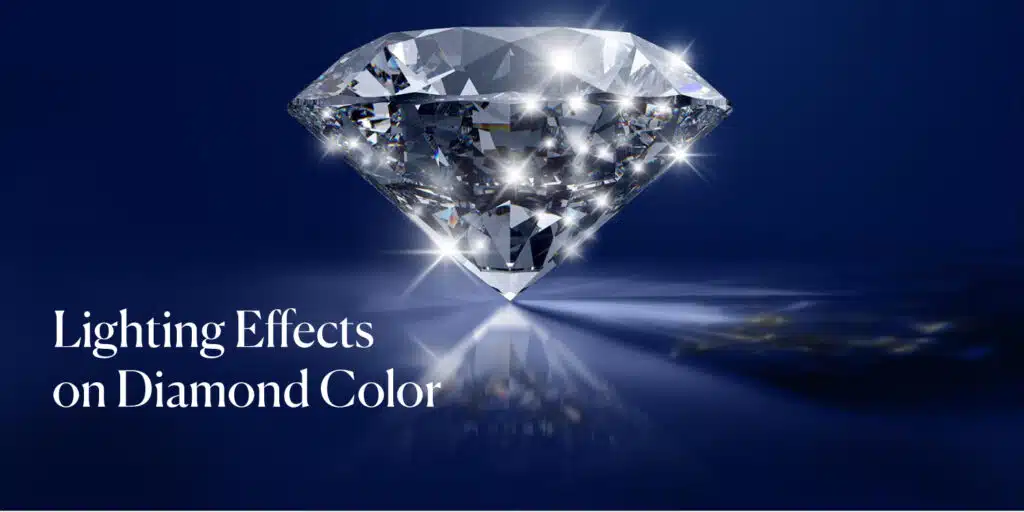
Let’s shine a light on how different lighting affects the color scale diamonds in your collection! The color and clarity of diamonds can look different depending on the lighting environment, which is why understanding these effects is key to choosing the right stone.
I’ll walk you through how various lighting conditions impact your diamond’s appearance, so you can see its true beauty with this diamond color guide.
The color of a diamond can shift under different lights, making it look whiter, warmer, or more vibrant depending on the setting. Knowing this helps you pick a diamond that looks stunning in the environments where you’ll wear it most.
How Different Lighting Affects Diamond Color
Let’s explore how lighting changes the look of your diamond. Here’s how different lighting conditions can affect the color scale diamonds you’re considering:
- Natural Light: In sunlight, a diamond’s warmth shines through, making faint yellow tints more noticeable—for example, a 1-carat L color, VS2 clarity, excellent cut at James Allen will show its warm, golden hue beautifully.
- Store Lighting: Under bright, white store lights, diamonds often look whiter than their grade suggests—like a 1-carat K color, VS2 clarity, excellent cut at Blue Nile, which might appear closer to a near-colorless grade in this setting.
- Home Lamps: Incandescent or LED home lighting gives a crisp but warm glow, balancing a diamond’s color—for instance, a 1-carat Z color, VS2 clarity, excellent cut at Ritani will look vibrant with its yellow tint softened slightly.
Lighting can make a big difference in how you perceive the color and clarity of diamonds, so it’s worth seeing your diamond in various conditions. This ensures you love how it looks no matter where you are.
Tips for Evaluating Diamond Color in Lighting
How can you make sure you love your diamond’s color?
My top tip is to test your diamond in multiple lighting conditions before buying—for example, at James Allen, you can view diamonds in different lights using their 360-degree video feature.
This helps you see how the color of a diamond changes from natural daylight to indoor settings, ensuring there are no surprises. When shopping for color scale diamonds, look for deals during sales, as I discuss in my guide on do diamond rings go on sale.
Why test in different lights? A diamond that looks perfect in store lighting might show more warmth at home, so seeing it in various environments helps you make a confident choice. This step ensures your diamond looks amazing wherever you go.
Lighting plays a huge role in how you experience your diamond’s color. By understanding these effects, you can choose a stone that looks stunning in all the places you’ll wear it.
Lab-Grown vs. Natural Diamonds: Color Considerations

Let’s compare lab-grown vs. natural diamonds and see how diamonds color plays a role in your decision! Both diamond types—lab-grown and natural—offer stunning options, but their color profiles and pricing can differ significantly.
The color of a diamond affects its appearance and value, and lab-grown diamonds often have an edge in achieving whiter grades more consistently. Understanding these differences can help you make a choice that fits your style and budget.
Color Differences: Lab-Grown vs. Natural Diamonds
How do lab-grown and natural diamonds compare in terms of color? Lab-grown diamonds are often whiter because they’re created in controlled environments, making it easier to achieve colorless grades like D—for example, a 1-carat lab-grown D color, VS2 clarity, excellent cut at James Allen costs $4,800.
Natural diamonds, on the other hand, show more variation in color due to their formation in the earth, with a 1-carat natural D color, VS2 clarity, excellent cut at Blue Nile priced at $6,900. The diamond type you choose can affect color availability, as I explore in my types of lab-grown diamonds.
Lab-grown diamonds give you a better chance at a whiter stone for less, while natural diamonds might have slight color variations that add to their unique charm. It’s all about what you value more—consistency or natural rarity.
Pricing and Value Considerations
How does color impact the cost of lab-grown vs. natural diamonds? Lab-grown diamonds are typically 20-30% cheaper than their natural counterparts, even for the same color grade, making them a budget-friendly option for colorless stones.
For instance, the $4,800 lab-grown D color diamond at James Allen is significantly less than the $6,900 natural D color diamond at Blue Nile, despite both being colorless. This price difference makes lab-grown diamonds an attractive choice if you’re prioritizing a whiter diamonds color without the higher cost.
What about quality assurance? GIA certified synthetic diamonds ensure quality in lab-grown options, as I discuss in my GIA certified synthetic diamonds. This certification gives you confidence that your lab-grown diamond meets the same standards as a natural one.
Choosing Between Lab-Grown and Natural Diamonds
Which diamond type is right for you based on color? If you’re after a colorless diamond like D-F and want to save money, a lab-grown diamond might be your best bet due to its whiter consistency and lower price.
However, if you value the natural rarity and unique variations of a natural diamond, you might prefer its one-of-a-kind charm, even if it costs more. The diamond type you choose depends on your priorities—budget and color consistency or natural authenticity.
Understanding how color differs between lab-grown and natural diamonds helps you make a confident decision. Whether you opt for the whiter, more affordable lab-grown option or the unique charm of a natural stone, you’ll find a diamond that suits your style.
FAQs on Diamond Color
Let’s wrap up with some frequently asked questions about diamond color to help you make the best choice for your jewelry! From understanding what color are diamonds on the GIA scale to figuring out what is a good diamond clarity to pair with your color grade, I’ve got you covered. These answers will clear up any doubts and guide you toward the perfect diamond for your needs.
These FAQs should answer your burning questions about diamond color! From understanding what colors can diamonds be to finding the best color for a diamond for your budget, you’re now equipped to choose the perfect stone.
Whether it’s a G color diamond for an engagement ring or a fancy colored gem, you’ll find the right fit with these insights!
Conclusion
We’ve explored the diamond color chart, and now you’re ready to choose the perfect diamond colors for your style and budget! From the colorless D to the warm Z and beyond to fancy colored gems, this diamond color guide has shown you how to find a diamond that matches your vision, whether you prioritize whiteness, value, or unique hues. Let’s recap the key takeaways to help you make your final decision.
For ultimate whiteness, go for a D color; for great value, G-J offers a near-colorless look; K-Z brings warmth and affordability; and fancy colors add rare, vibrant flair. Use this diamond color guide to create your dream ring at build your own engagement ring on James Allen. Shop diamonds across the color scale at James Allen or Blue Nile today and find the diamond that’s perfect for you!


